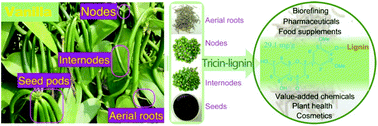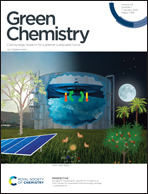Strikingly high amount of tricin-lignin observed from vanilla (Vanilla planifolia) aerial roots†
Abstract
Lignin has attracted tremendous interest as a renewable resource for biofuels, biomaterials, and chemicals especially in the era of bio-based refineries. The structural studies of lignin play an essential role in both understanding the nature and biosynthesis of these polymers and optimizing their valorization values. In this study, we have investigated the structures of lignin from different tissues—aerial roots, nodes, internodes, and seeds, from vanilla (Vanilla planifolia) by using gel permeation chromatography (GPC), heteronuclear single-quantum coherence (HSQC) nuclear magnetic resonance (NMR), and 31P NMR. An unusual tricin-lignin was observed in the aerial roots of vanilla with an strikingly high level of tricin unit, whereas the lignin from the nodes and internodes displayed traditional S/G type lignin with only 4–10% tricin abundance. The aerial roots lignin is primarily composed of β-O-4′ alkyl-aryl ether substructures (96% of linkages) in comparison to 65 and 73% in the nodes and internodes lignin, respectively. Thioacidolysis quantification results showed that lignin from aerial roots has 29.1 mg g−1 tricin, about 3- to 5-fold higher than the lignins isolated from nodes (10.1 mg g−1) and internodes (6.9 mg g−1). This communication of a particularly high level of tricin-lignin in vanilla plant has important impacts including: (1) the presence of the high amount of tricin as part of lignin from aerial roots could play a vital role for the valorization of lignin, even tricin itself, as a feedstock for value-added chemicals and commodities; and (2) it could open new ways to scientists to design and engineer the structure of tricin-lignin, or lignin in general, to confer plants with new or improved properties due to the plasticity of lignification.



 Please wait while we load your content...
Please wait while we load your content...